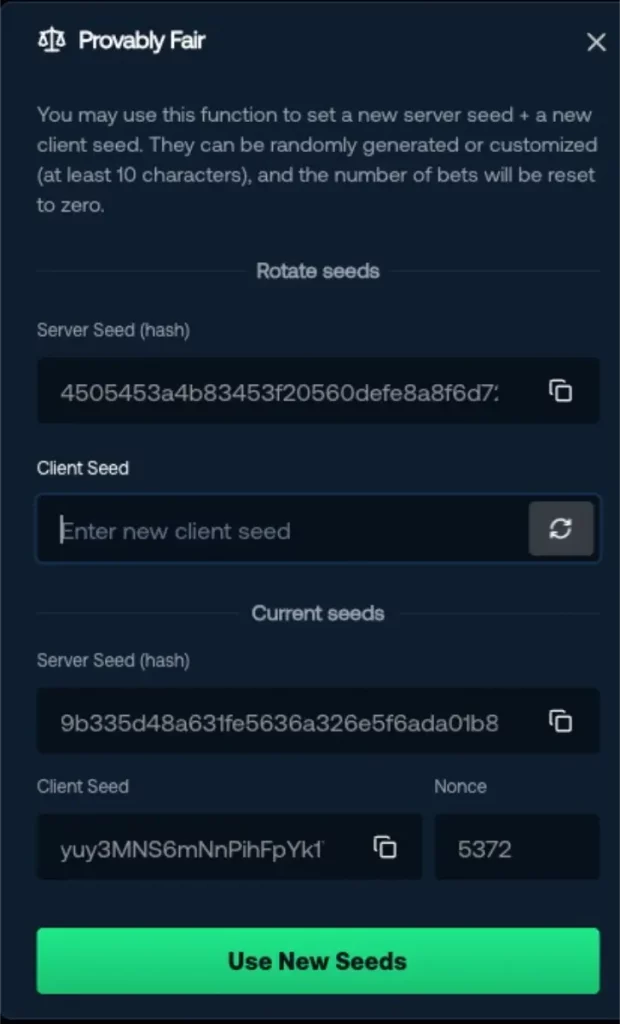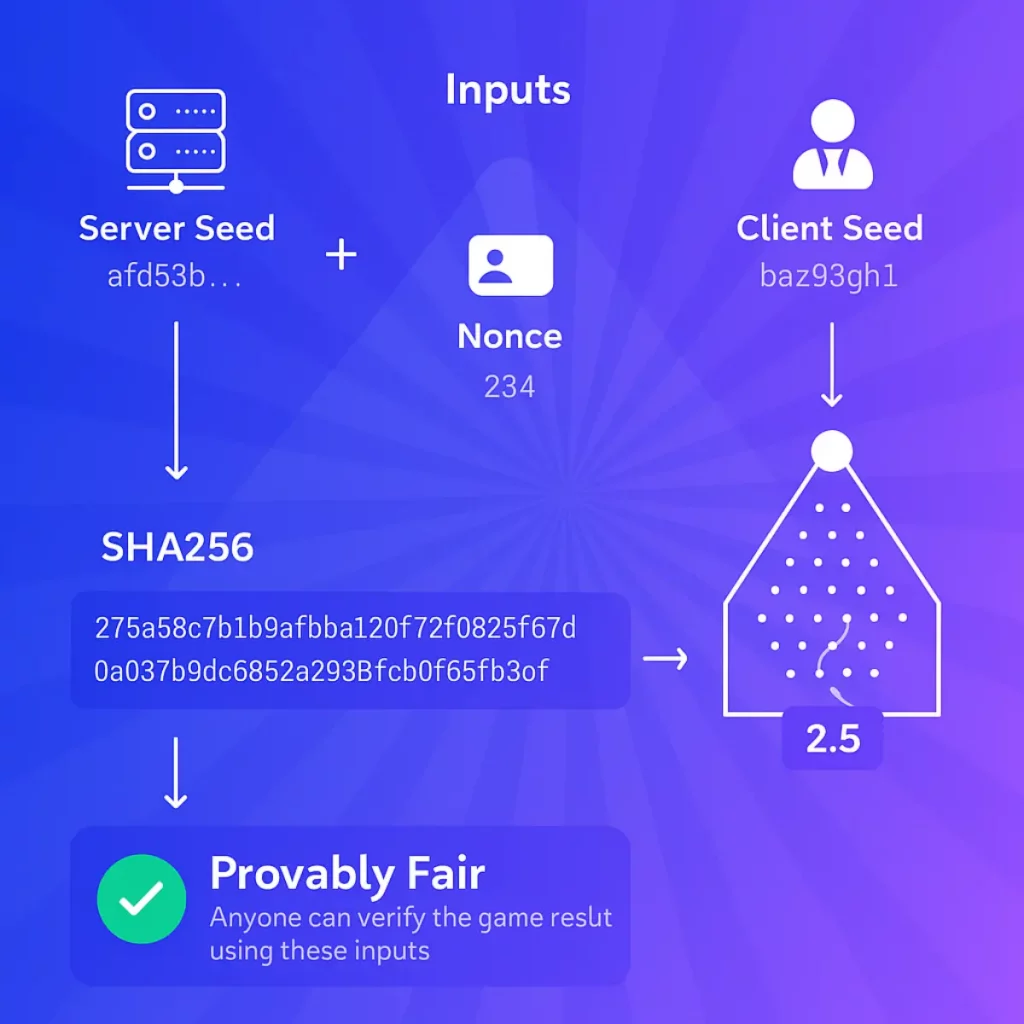
How does Plinko work? Algorithms behind casino Plinko games
I’ve been around crypto casinos long enough to see dozens of classic casino games get a Web3 glow-up.
But Plinko? That’s one game that’s quietly taken over the crypto market.
But here’s what most people want to know: is Plinko truly random, and can you trust the outcome, or is there some secret trick casinos use behind the scenes?
Let’s break it down.
🔑 Key Takeaways
- Every Plinko result is powered by server seed, client seed, and nonce, making each round unique.
- Provably fair tech lets you verify results in real time; you never have to blindly trust the casino.
- Risk level changes payout math, not randomness.
- No strategy can beat the house edge, but smart bankroll management goes a long way.
What decides your Plinko results? (RNGs and game logic)
In most crypto casinos, it’s a Pseudo-Random Number Generator (PRNG), which is a complex algorithm that spits out a random number for every game action.
Every Plinko drop starts with a random number generator (RNG), regardless if it’s your first or 100th drop.
How does the ball “fall”?
Most provably fair Plinko games simulate each “bounce” (peg) as a binary outcome:
- Left or right? RNG decides.
- The process repeats at every level until your ball lands in a final slot.
In some versions, the entire path is calculated at once based on the random seed(s) and nonce, mapping to a unique final bin/multiplier.
Either way, the whole path is dictated by a deterministic (but unpredictable) algorithm.
How do provably fair systems guarantee transparency in Plinko casino games?

Provably fair systems guarantee transparency by combining a server seed, a client seed, and a nonce, all hashed together to create a verifiable, tamper-proof result.
It’s the core mechanic behind every fair crypto Plinko round. And that’s the big difference between the TV Show The Price is Right...and crypto casino Plinko!
Here’s how it works:
- The server seed is generated by the casino.
It’s hashed and shown to the player before you start playing, proving they can’t change it afterward. - The client seed is either picked by you or generated on your device.
It adds an extra layer of randomness that the casino can’t control. - The nonce starts at zero and increments with each round.
It ensures that even if your seeds stay the same, every drop is still unique.
These three values are fed into a cryptographic hash function (like SHA-256 or HMAC-SHA512), which produces a random, but deterministic result.
That means the same inputs will always return the same result, which you can verify after each game.
Most casinos link to their own verification tools, or you can use public provably fair hash checkers.
Look for platforms certified by labs like iTech Labs, GLI, or eCOGRA, they test RNGs and fairness across the industry.
Stick with trusted casinos that let you verify every drop.
Why is the nonce critical for Plinko?

This is where Plinko (and dice, limbo, mines) differ from crash games.
- Plinko: Uses the same seeds for multiple rounds, so each round increments the nonce to generate a new, independent result.
- Crash: Most crypto crash games use a new server seed per round, so there’s no need for a nonce. Each round is already unique by default.
If you play 100 Plinko rounds without changing your seed, your 100 results will all look random and independent, thanks to the nonce.
How are risk levels and multipliers set?
Each risk level comes with a predefined multiplier curve, and the game assigns probabilities to each slot accordingly.
You don’t get random multipliers, you get a random result that’s mapped to a fixed multiplier table, depending on your chosen risk.
Here’s how it breaks down:
- Low risk: Most outcomes fall in the middle slots with 1.1x to 2x payouts. You’ll win more often, but the rewards are smaller.
- Medium risk: A balanced curve with fewer small wins and slightly better odds at 10x+.
- High risk: The curve flattens out. Most balls land on 0.2x or 0.4x, but the edges of the board unlock massive 100x or even 1,000x payouts. These are ultra-rare, but they’re what high-risk players chase.
Each Plinko game has its own multiplier table for each risk level and number of rows (commonly 8, 10, 14, or more).

Behind the scenes, the game provider assigns fixed probabilities to each possible landing bin, and the odds are what define the house edge and return-to-player (RTP) rate.
👉 The randomness (from the seed + nonce combo) just picks a single slot on the board. The reward for that slot is predetermined based on your chosen risk.
This is why switching risk level mid-session immediately changes your expected outcomes, not because the RNG changes, but because it now maps to a different multiplier structure.
Want to check the numbers?
Most games list their RTP and payout tables inside the info or fairness tab.
How do you verify your Plinko game is fair?
You verify it by cross-checking the server seed, client seed, and nonce against the round outcome.
If the game’s truly provably fair, you can recreate the result using the exact same inputs, proving the casino didn’t tamper with it.
Here’s what that process looks like:
- Copy the server seed, client seed, and nonce for any game round.
- Use the casino’s tool to run the same hash function.
- Confirm that your outcome matches what the casino showed.
If it doesn’t match? You caught a scam (or, more likely, you copied a value wrong).
Tip: You must check all three values. If a Plinko game hides any of these, you can’t verify true fairness.
Can you predict or hack Plinko results?
No, you can’t hack Plinko, and you can’t predict it. Every round’s result is driven by a cryptographically secure algorithm that combines the server seed, client seed, and nonce.
Unless you can break SHA-256 or HMAC-SHA512 (spoiler: you can’t), the outcomes are uncrackable.
Let’s see why:
- Each round is unique: The nonce guarantees that even if your seeds stay the same, the hash changes every time. There’s no repetition or pattern to exploit.
- The algorithm is deterministic but unpredictable: If you know all the inputs (server seed, client seed, nonce), you can recreate the exact outcome. But without the secret server seed (revealed only after it expires), there’s no way to reverse-engineer or forecast future results.
- No third-party tool, browser extension, or “Plinko strategy script” will crack it: Anyone selling you a “Plinko hack” is either running a scam or has no idea how provably fair systems work.
- The house doesn’t need to cheat anyway: The math is already in their favor. The house edge is baked into the payout structure, not the randomness. There’s no need to manipulate results, and if they did, players would catch it instantly by verifying the seed/hash.
Plinko is built to be provably fair and unhackable.
If someone claims otherwise, they’re either misinformed or trying to take your money.
What’s the best way to play Plinko responsibly?
Play with a clear bankroll, choose a risk level that matches your goals, and always verify fairness.
If you want to learn how to play Plinko, you need to start with the basics.
Plinko might be simple on the surface, but it moves fast and can eat through your balance before you know it.
Here’s how I do it (and I think it’s a good idea for you, as well!):
- Set a budget before you start
Decide how much you’re okay with losing, and stick to it. Plinko’s speed makes it easy to get carried away. - Use auto-play settings with loss/win limits
Many crypto casinos let you set rules like “stop after X losses” or “stop if profit hits Y.” Use them, they’re lifesavers. - Pick the right risk level for your playstyle
Low risk = frequent but smaller wins. High risk = long dry spells with rare, massive payouts. If you’re chasing 1,000x, be ready to lose a lot along the way. - Don’t chase losses
This one’s universal. If you’ve had a bad streak, take a break. Don’t try to “win it back” by cranking up your stake or switching risk levels randomly. - Always verify fairness
Every round. Every time. If the game doesn’t show you the server seed hash, client seed, and nonce, walk away.
Plinko is fair, but it’s still gambling.
The math favors the house over time. Your best edge is knowing how the system works and gambling responsibly and on your own terms.
Final words
Plinko delivers a good mix of simplicity, speed, and provable fairness in a way few casino games do.
Behind each drop is an algorithm that is protected by secure seeds and a nonce system that guarantees randomness.
Stick to trusted sites, verify your rounds, and let smart play guide your luck.








